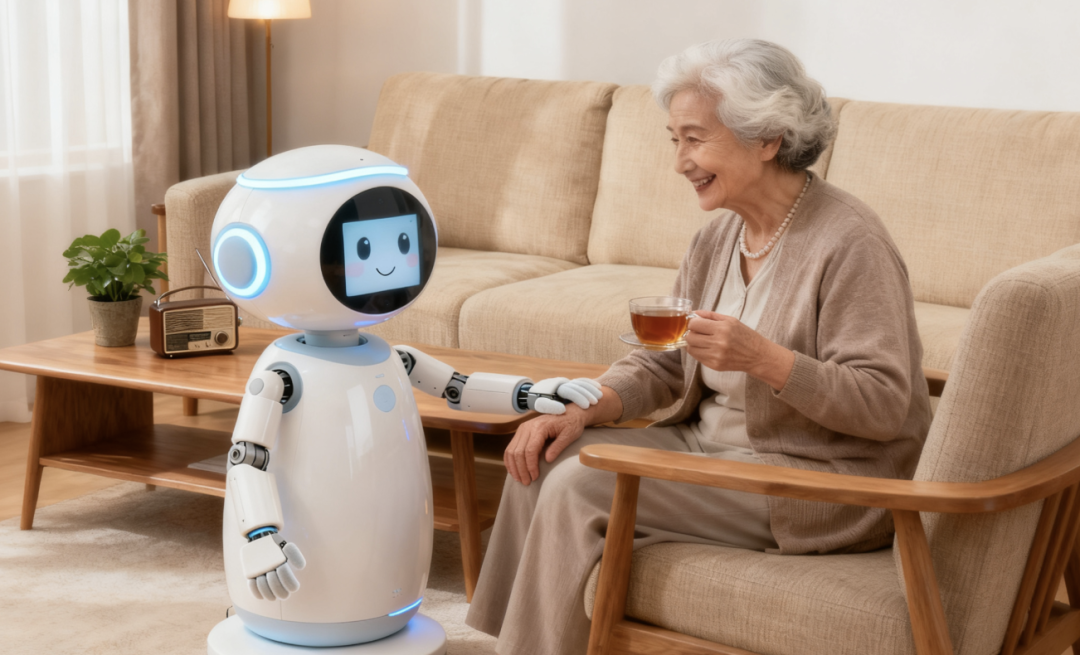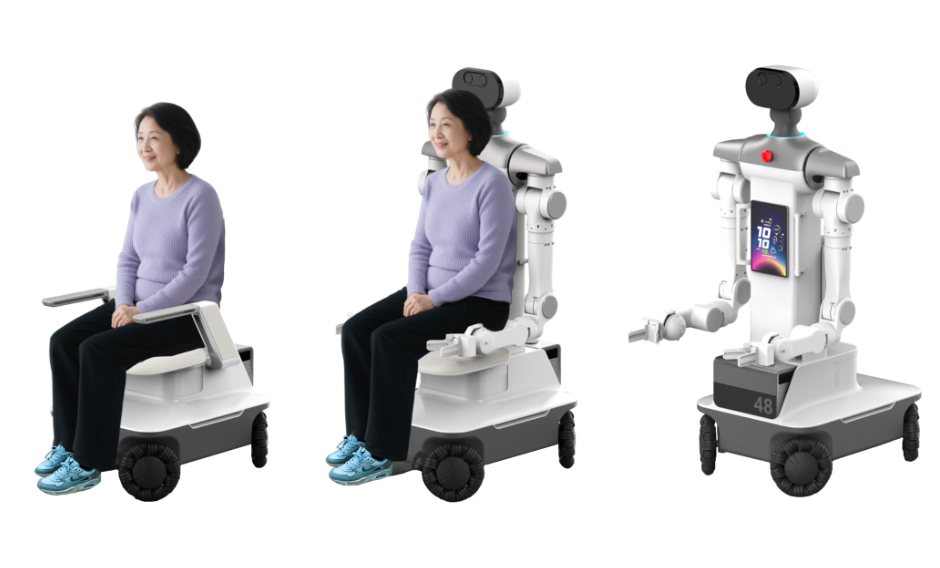Academician's Protégé Develops Healthcare Robots: Stepping into a Billion-Dollar Market with Millions in Investment
![]() 10/13 2025
10/13 2025
![]() 428
428

Interview & Writing | Pencil News Song Ge
Elderly care is rapidly emerging as a significant challenge that the only-child generation of the '80s and '90s must confront.
Envision a future where only children no longer have to fret about remotely caring for their aging parents. Elderly care robots can step in to assist with meal preparation, offer companionship through conversations, and even read bedtime stories to aid sleep. For disabled seniors, frequent trips to rehabilitation centers will become unnecessary, as home-based wheelchair humanoid robots can provide professional rehabilitation training.
Shanghai Rushen Robotics Technology Co., Ltd. (Rushen Robotics) is dedicated to developing elderly care and rehabilitation robots, striving to find technological solutions to the escalating elderly care challenges in an aging society.
The founder of Rushen Robotics, Shi Yunlei, earned his Ph.D. in Informatics from the University of Hamburg, Germany, under the tutelage of Professor Jianwei Zhang—a world-renowned artificial intelligence scientist, a member of the German Academy of Engineering, and a foreign member of the Chinese Academy of Engineering. Shi also holds a master's degree from the School of Mechanical Engineering at Tianjin University, where he studied under Academician Shuxin Wang, a pioneer in medical robotics in China.
Shi Yunlei is a seasoned serial entrepreneur with over a decade of experience in medical robotics. He co-founded the Hong Kong-listed company MicroPort® Robotics and the super unicorn company Agile Robots. In 2023, he co-founded Rushen Robotics alongside his Ph.D. advisor. "We aim to solve the elderly care problems for all only children, realizing the ideal of 'caring for our own elderly and extending that care to others,'" Shi remarked.
Rushen Robotics' product lineup focuses on rehabilitation and elderly care. Its first mass-produced offering is the 'GeWu Series' home multi-function rehabilitation robot, designed to meet the needs of disabled individuals in maintaining physical function and restoring daily living abilities. The second product is the 'QiJia Series' home elderly care robot, targeting semi-disabled seniors with needs for daily living assistance, mobility support, and emotional companionship.
In September 2025, Rushen Robotics announced the completion of two consecutive funding rounds: an Angel+ round exclusively invested in by Daotong Investment and an Angel++ round led by Lihe Finance. In just two years since its inception, the company has secured five rounds of financing, swiftly becoming a leading team in the embodied intelligent healthcare robotics sector.
Currently, China's healthcare robotics industry is experiencing rapid growth. According to relevant data, the market size for elderly care robots in China surpassed 10 billion yuan in 2024. With the aging population rate continuing to rise (projected to exceed 25% for those over 60 by 2030) and over 90% of elderly care needs being met at home, healthcare robots equipped with AI interaction and multi-scenario adaptability are becoming crucial in addressing "elderly care challenges." The industry's annual growth rate remains above 30%, with home-based healthcare scenarios seen as the core growth area for the robotics industry in the next 3-5 years.
The healthcare robotics industry is capitalizing on opportunities from rapidly declining hardware costs and upgraded AI interaction capabilities but also faces challenges in "meeting scenario demands with functionality" and "affordability."
Recently, Pencil News spoke with Shi Yunlei about the product features and business opportunities of healthcare robots. Below are the highlights of their conversation.
Disclaimer: The interviewee has confirmed the accuracy of the information in this article, and Pencil News stands by its credibility.
- 01 - Making Healthcare Robots Affordable for Families
Pencil News: What are the technological advantages of Rushen Robotics?
Shi Yunlei: Our first advantage lies in product design. We don't merely replicate humanoid forms; instead, we delve into specific scenarios, analyze user needs, and create targeted products. For instance, disabled individuals require both mobility assistance and daily living care, prompting us to design a wheelchair humanoid robot.
Our second advantage is interaction capability. Since our products interact directly with humans, we've accumulated significant expertise in natural language and force interaction. These interaction technologies have been extensively validated in domestic surgical robots and collaborative robot products.
Our third advantage stems from our technical background. Leveraging the Multimodal Technology Institute at the University of Hamburg, Academician Zhang Jianwei's team possesses strong expertise in multimodal information acquisition, fusion, and modeling, which feeds back into our product development.

Founder of Rushen Robotics, Shi Yunlei
Pencil News: What was the biggest technical challenge during development?
Shi Yunlei: We faced numerous challenges. For example, we're tackling the "force control" problem. When a robot assists an elderly person in standing up, it needs to know precisely how much force to apply. This involves complex modeling and real-time calculations.
We input the elderly person's weight parameters in advance, then use joint sensors to detect the force on each linkage, calculating the optimal force for safe and effective assistance. Traditionally, robots only detected force at the end effector, but elderly care scenarios demand full-body real-time force detection by the robotic arm, which is a significant challenge.
Pencil News: How do you collect scenario data during research and development?
Shi Yunlei: We conduct extensive interviews, observations, and measurements. We have strategic partnerships with leading elderly care institutions like Fushoukang (Fushoukang Smart Medical and Elderly Care Services (Shanghai) Co., Ltd.), which provide numerous real-world scenarios and needs. For example, we discovered that female caregivers hired by institutions often lack sufficient strength, and many beds are not electric, making standing assistance and bed-to-chair transfers major pain points.
Pencil News: How do you ensure safety when robots interact with humans?
Shi Yunlei: While I can't delve into specific technical details, we bring experience from medical robotics, where risks are even higher, such as inserting robots into the human body during surgery. Compared to that, the safety challenges of elderly care robots are lower, but we still design them to medical robot safety standards to ensure no harm comes to the elderly.
Pencil News: How is product acceptance among the elderly and their families? Any typical cases?
Shi Yunlei: Acceptance is high. Rehabilitation is a rigid demand, but traditionally, users needed someone to accompany them to institutions, costing 300-400 yuan per session (not covered by medical insurance), plus transportation costs, making it expensive and burdensome. Our products enable at-home rehabilitation, significantly reducing costs and providing professional guidance.
For example, in Europe, some rehabilitation clinics bring our products directly to users' homes, with excellent results. Similar cases exist in Southeast Asia, like Malaysia.
For elderly care robots, there's a strong "desire" and even optimism. During tests in nursing homes, elderly residents were excited to see robots fetch items, interact naturally, and chat.
Pencil News: Will ordinary families be able to afford elderly care robots in the future?
Shi Yunlei: Our vision is that, long-term, their price will be comparable to major household appliances, with a few tens of thousands of yuan buying an autonomous robot.
However, in the short term, due to limited autonomy, remote human assistance or even in-home caregiver visits may still be needed, leading to a "service fee" model. We aim for monthly fees between 3,000-4,000 yuan, which is lower than the ~10,000 yuan cost of in-home caregivers or the 5,000-10,000 yuan monthly expense of nursing homes. Combined with the greater freedom of aging at home, many families will prefer this option.
- 02 - Elderly Care Robots Must Consider Emotional Companionship
Pencil News: What's the biggest change AI has brought to healthcare robots?
Shi Yunlei: The change is obvious. Previously, robot-human interactions were specialized, relying on programming or preset rules. Only in this AI revolution can robots communicate naturally with humans. Simply put, you can tell the robot what to do in natural language, and it executes based on language instructions and environmental observations—the so-called "VLA model" concept.
Past food delivery or hotel robots required manual input, like room numbers, to complete tasks. Now, you can directly tell the robot to deliver something to a specific room, and it understands and executes. This interaction style is particularly suited for elderly users in healthcare scenarios.

Rushen Robotics Product Image
Pencil News: In your interactions and research with users, have you found differences in needs between elderly and younger groups?
Shi Yunlei: The differences are significant. For our first robot, which lacked voice interaction, users had to set rehabilitation parameters via a software app. Younger or slightly older adults could manage it, but much older individuals struggled and needed help.
For our second robot, targeting older, more functionally limited individuals, we focused on natural language interaction. They can't use finger-based tablet operations, so the robot must proactively observe and suggest services, with the elderly simply confirming. This differs from traditional robot interaction—previously, humans issued commands, and robots executed them. In healthcare scenarios, the robot often leads, with users cooperating.
Pencil News: Is there a large demand for emotional companionship among the elderly? Will Rushen Robotics incorporate such features?
Shi Yunlei: Yes. We envision the robot as modular. For example, when an elderly person goes to bed, the interaction module can be detached and placed beside the bed, providing companionship and telling a bedtime story to help them relax. Meanwhile, the robot's main body can perform other tasks or await further instructions.
This approach provides both functional services and emotional companionship.
Pencil News: Can elderly care robots fully replace human caregivers in the future?
Shi Yunlei: Not in the short term. Care involves both hardware and software. Even with advanced large models, if the hardware is inadequate—e.g., insufficient multimodal sensors, limited manipulation, and load capacity—many tasks remain impossible.
Care details are highly complex. For example, elderly individuals often suffer from constipation, requiring manual assistance—a task robots currently struggle with. Human hands are incredibly sophisticated tools with force control, temperature sensing, tactile feedback, heat resistance, and waterproofing, which are difficult for robotic hands to fully replicate.
- 03 - Commercial and Home Scenarios Drive New Robot Opportunities
Pencil News: The robotics industry is booming. How do you predict its future development?
Shi Yunlei: It broadly falls into humanoid and non-humanoid categories. Humanoids focus on motion control and mobility; non-humanoids include various types like industrial and collaborative robots.
We believe the future will resemble automobiles, with different forms for different scenarios. Home healthcare scenarios demand high safety, making non-humanoid solutions more suitable. Our products combine mobility and dual-arm manipulation, offering advantages in healthcare scenarios.
For example, our wheelchair robot can move autonomously when unoccupied and use its arms as handrails to assist with bed transfers when occupied, offering higher safety than humanoids, which could topple over if they fail.
Pencil News: What are the most promising scenarios?
Shi Yunlei: Industrial robots have already seen massive adoption, with millions deployed in automotive and manufacturing plants. Collaborative robots have shipped in the tens to hundreds of thousands. Service robots, like those for hotel room delivery, are also relatively widespread.
For "embodied intelligent robots" to see mass adoption, two conditions must be met: functionality must be truly adequate for the scenario, and costs must be low enough.
Past examples include robotic vacuum cleaners, which liberated users from manual cleaning and provided tangible benefits (time and emotional savings), leading to rapid adoption. Embodied intelligent robots must follow this ROI (Return on Investment) principle.
Costs are already declining rapidly. Three years ago, a quasi-direct drive motor I used in experiments cost 1,800 yuan; now, it's just over 400 yuan, a 75% drop. Hardware cost trends are clear. Next comes functional breakthroughs. For instance, if boxing robots can achieve real-time motion cloning and even spawn commercial projects like "robot boxing matches," it could drive new mass applications.
The most promising scenarios are commercial and home environments, involving high-frequency human interaction where natural language and large models can truly shine. Our focus on healthcare scenarios is driven by demand and the potential for technological breakthroughs.
Pencil News: What's your ideal vision for robots?
Shi Yunlei: Loyal, safe, and highly capable. Whether humanoid or not is secondary; the key is safety, controllability, and genuine assistance to humans.
Pencil News: Will you pursue global expansion? What are the differences between Chinese and overseas markets?
Shi Yunlei: From inception, we've been a globally oriented company. Most of our founding team members hail from German universities and enterprises, and our chief scientist, Academician Zhang Jianwei, is a member of the German Academy of Engineering. We deeply understand both overseas and Chinese markets, so going global was a clear goal from the start.
There are notable disparities in the market. Let's take rehabilitation robots as an illustrative case: overseas, several decades of educational and philosophical efforts have fostered a broad acceptance of proactive rehabilitation. In this context, patients are well - informed to initiate motion rehabilitation promptly after surgery, as opposed to adhering to the traditional Chinese approach of static recovery, which has persisted due to historical factors. Consequently, our inaugural product enjoyed robust sales in international markets. Within China, orders are predominantly concentrated in major cities, where doctors and users exhibit a greater openness to new rehabilitation concepts.
Moreover, China's expansive market presents distinctive opportunities. For our second product, which necessitates remote operational support, we have the option to set up remote service centers in regions characterized by lower labor costs. These centers can then effectively support users located in eastern China—a business model that would be less practical in many developed countries. Hence, China's market boasts unique advantages.
At present, our products are being sold in East Asia, Europe, and North America. We have received enthusiastic feedback, and the demand for our products currently surpasses our supply capacity.
This article embodies the independent perspectives of the interviewee and does not represent the official stance of Pencil News. Furthermore, it should not be construed as investment advice.








